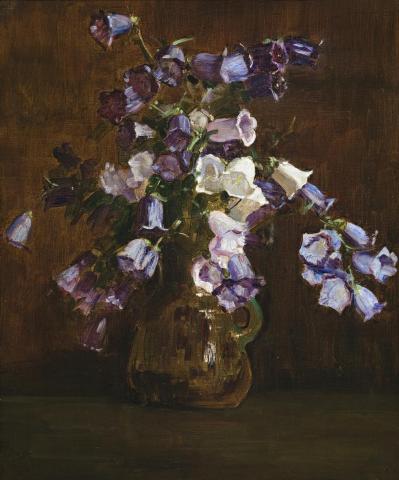CANTERBURY BELLS, PURPLE AND WHITE, 1928
Arthur Streeton
oil on canvas
61.0 x 51.0 cm
signed lower left: A STREETON
Miss M. Bulivant, Melbourne
Private collection, Melbourne
Deutscher~Menzies, Sydney, 10 – 11 March 2004, lot 100
Private collection, Melbourne
Arthur Streeton, The Fine Art Society, Melbourne, 4 – 20 April 1929, cat. 15 or 16
‘Mr. Streeton's Paintings', Argus, Melbourne, 4 April 1929, p. 15
Streeton, A, The Arthur Streeton Catalogue , Melbourne 1935, cat. 969
In a letter of 1934 to his fellow artist Julian Ashton, Streeton wrote of the numerous bulbs he had planted in the garden of his property'Longacres' in the Dandenong Ranges near Melbourne.
'... about 60 lilie [sic] bulbs (Madonna or Coudidium) and they have increased to over 2000, also a great mound of Tiger Lilies which grow to 7 feet high and have over 50 blooms on the stalks - also lillies 'Regal' and 'Auratum' - also Canterbury Bells of all colours - by the hundreds...'1
The latter are celebrated in our painting and in handsome array in the larger work, Lilies and Bells, 1935, in a private collection.2 The subject had a special appeal for Streeton painted two versions of Canterbury Bells (Purple and White), showing them both in his solo exhibition at the Fine Art Society's Gallery in Exhibition Street, Melbourne in the autumn of 1929.3 The mixed exhibition of landscapes and flowers included such significant works as Mirage, Riverina and Our Vanishing Forests, together with an array of Streeton's garden treasures - Riverina Roses (Lindsay Field's 12 best), Rhododendron (both at the then not inconsiderable amount of 200 guineas each), Gladiola, Sunflowers, and Michaelmas Daisies.
Describing the exhibition as the work of 'one of our Australian masters', the art critic for the Argus noted, in addition to the landscapes, 'flower paintings showing much ability. That of rhododendrons is especially notable, and there are others that invite attention, commemorating gladioli, Canterbury bells, and miscellaneous blossoms.'4 While the Age acknowledged the 'flower studies' as 'an important feature of the exhibition', the Herald critic went further stating that 'certain sound judges' hold that in years to come a Streeton still-life of the latter period will be held in as great, if not in greater, esteem than the landscapes of the middle period.'5
While a happy occupation of his old age, Streeton's interest in painting flowers had a longer history, his Honesty and Artichokes being included in The 9 by 5 Impression Exhibition of 1889. Their greatest outpouring, however, was during the 1920s into the 1930s when he painted some 150 such delightful works, responding both to an eager public and his own interests. In Canterbury Bells Purple and White, the devoted painter-gardener focused his attention on the flowers and their container, concentrating on colours, textures, and the lyrical fall of light on petals and supporting vase.
1. Quoted in Smith, G., Arthur Streeton 1867-1943, National Gallery of Victoria, Melbourne, 1995, p. 182, from Wray, C., Arthur Streeton: Painter of Light, Jacanda Wiley, Milton, 1993
2. Illustrated in Smith, op. cit, p. 183
3. A slightly larger Canterbury Bells was shown in Streeton's exhibition of March 1932, cat. 3
4. Argus, op. cit
5. 'The Art of Arthur Streeton: Landscapes and Flowers', Age, Melbourne, 4 April 1929, p. 12;'The New Streeton's Old Power', Herald, Melbourne, 3 April 1929, p. 22
DAVID THOMAS
